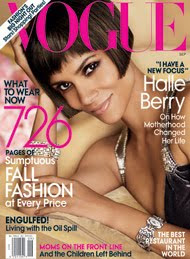I found this article really interesting, it came in an emailer by Advertising+Marketing Magazine.
Opinion - Vogue could be described as nothing more than a glossy catalogue. Every fashion ad follows the same formula. Sexy models draped in a fashion house's latest range, shot and styled by a big name photographer and finished off with the logo.
However, the print ads confirm the prestige of the brand. They're almost arrogant as they seductively announce "Look at how much money we have". By placing an ad in Vogue they are re-assured that they're reaching the 'right' people and the people who aspire to be part of the set. It's a formula that apparently works.
The big players have always placed emphasis on story telling and dramatic theatre. When it comes to their shows they create truly aspirational brand experiences. There have been innovations in the form of holographic musion projections and extended filmic TV ads for the likes of Chanel. And every new fashion show/experience becomes more elaborate than the last. All of this is driven by PR and being in the know. They fuel the fires of desire and generate the need to be invited to 'the next big thing'. This feeling of exclusivity is key to the experience.
However, high-end fashion houses seem to have an element of nervousness around the digital space and this probably comes down to control. But more importantly the accessibility to all scares them. Luxury brands have been burnt in the past by trying to widen their consumer base. Burberry and the adoption by the "chav" class of the UK is one classic example. The power fashion houses seem to need to keep a distance to maintain desire for the brand, as all luxury brands do.
There's now a growing need from consumers to justify the badge. Consumers are no longer just buying the badge but they are also buying the story behind the brand. They have a desire to know more. Different types of fashion brands need different approaches. It's important to make the distinction between the high-end and the diffusion lines. But in general consumers are demanding more.
Our work for DKNY Jeans is aimed at a wider audience but we're doing what the high end shows do best. We're building a compelling story around the brand whilst offering exclusivity in terms of getting hold of the latest range before anyone else. Our story set in a infamous New York hotel is full of mystery and intrigue. We've chosen to create immersive branded content to engage the audience. The story will unfold in real time using a combination of Facebook, Twitter, MySpace and YouTube. The people who visit Room 333 online will find value on a number of fronts. Firstly they'll be entertained, whilst learning about the brand and secondly they'll be rewarded for their time and effort.
The opportunities to generate interest around a fashion brand digitally shouldn't be overlooked by fashion houses. Diesel, more of a mainstream fashion brand, has led the charge over the last few years in our digital world. Admittedly their target consumer is youth and the brand's irreverent tone makes online and social networks natural choices. And other luxury brands such as Raymond Wei are starting to dip their toes into the social world of Facebook. The Swiss watchmaker is actually asking consumers to define the future direction of the brand.
So, a few brands are pioneering a new approach and I think we'll see more examples of fashion brands creating quality branded content with deeper engagement in the future. However, fashion's big guns may well find it hard to wean themselves off their diet of print ads, product placement, spectacular shows and unofficial celebrity endorsements.
Grant Hunter is regional creative director at iris for Asia Pacific at Cream Global, Global


No comments:
Post a Comment